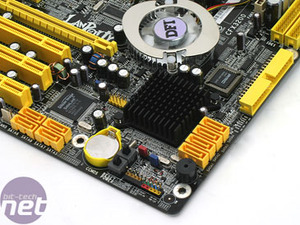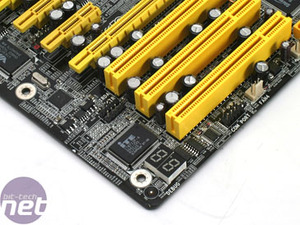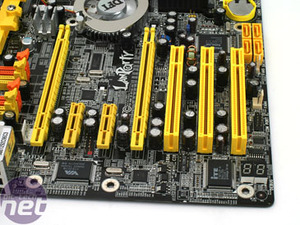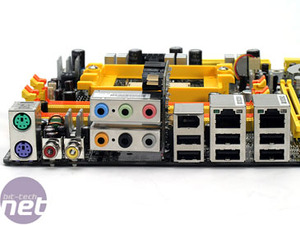The BIOS chip is located in between the north bridge and the floppy connector. The north bridge and south bridge are remarkably close to each other - there's more distance between the north bridge and the CPU socket than there is between the north and south bridges. The ULi M1575 south bridge is passively cooled with a black aluminium heatsink. There are four SATA 300MBps controlled by the south bridge and they are located along the edge of the board.
Moving further down the edge of the motherboard, DFI has implemented a system buzzer. By default, the buzzer is turned on, but there is a jumper allowing you to disable the buzzer if you prefer not to have it beeping every time you turn on or reboot your computer. The CMOS reset jumper is the red jumper located next to the buzzer jumper.

 The board features the increasingly useful power and reset switches that have been on DFI's products since the nForce2 days, shown here next to the battery. However, DFI has chosen to improve things a little with the CFX3200-DR. When overclocking, one of the biggest pet peeves I've personally had was the fact that when I overclocked things a step too far, I'd have to reset CMOS. Resetting the CMOS jumper is a hassle at the best of times when the board is out of a case, nevermind when its in one.
The board features the increasingly useful power and reset switches that have been on DFI's products since the nForce2 days, shown here next to the battery. However, DFI has chosen to improve things a little with the CFX3200-DR. When overclocking, one of the biggest pet peeves I've personally had was the fact that when I overclocked things a step too far, I'd have to reset CMOS. Resetting the CMOS jumper is a hassle at the best of times when the board is out of a case, nevermind when its in one.
If you press both the onboard power and reset switches together after the board fails to POST, the board automatically resets the CMOS for you without having to power the system down. Some motherboard manufacturers have implemented a safe mode into their boards without the need for user interaction - this is slightly different as it resets the BIOS. Either way works for us, simply having the option makes a massive difference - it got its fair share of use during our overclocking experiments.
DFI still uses the same Silicon Image Sil3114 SATA 150MBps disk controller on the CFX3200-DR. This has been on all of DFI's LANParty motherboards with an additional disk controller for some time now, and we would've hoped that the mobo maker would've updated to the Sil3132 SATA 300MBps controller. The four ports controlled by it are located next to the bottom PCI slot. There's also a serial port header along the bottom of the board, too.

 On older DFI motherboards, there was set of LEDs designed to show diagnostic readouts. This was great, to an extent, but it had its limitations. The LANParty UT CFX3200-DR features a POST code readout display, making things easier to diagnose - the readout codes are said to be located at the back of the manual, but we couldn't find them anywhere. This makes the feature a little useless - hopefully this will be remedied soon.
On older DFI motherboards, there was set of LEDs designed to show diagnostic readouts. This was great, to an extent, but it had its limitations. The LANParty UT CFX3200-DR features a POST code readout display, making things easier to diagnose - the readout codes are said to be located at the back of the manual, but we couldn't find them anywhere. This makes the feature a little useless - hopefully this will be remedied soon.
There are two Marvell Yukon PCI-Express based ethernet connectors on the board (88E8052 and 88E8053) - this is good to see as we've seen some motherboard makers using PCI gigabit ethernet controllers for the secondary controller. Some may argue that dual ethernet sockets are relatively useless.
However, it's possible to team the two ports together. In our preliminary testing, we didn't see any transfer rate benefits from teaming the two network ports together, but there is the redundancy factor if its important for your machine to remain connected to the internet at all times, even if one of the ports was to fail. Bridging the two network adapters together means that the internet connection isn't lost if one of the ports failed.
The back panel is legacy free, with the exception of the PS/2 ports. As aforementioned, DFI uses its Karajan audio module. It has the audio codec located on a separate module that completely removable - this allows for greater signal quality and less hiss from other traces on the motherboard. It uses the Realtek ALC882 high definition audio codec and features support for eight channel audio via six analogue audio jacks. There is also a CD-In header and S/PDIF RCA In and Out ports.
The rest of the back panel is dominated by USB 2.0 ports, with six in total. There is one additional USB header located next to the south bridge and Sil3114 disk controller, making a total of eight USB 2.0 ports. Finally there is one IEEE1394a Firewire and two Gigabit Ethernet sockets to complete the array of ports on the back panel.
Moving further down the edge of the motherboard, DFI has implemented a system buzzer. By default, the buzzer is turned on, but there is a jumper allowing you to disable the buzzer if you prefer not to have it beeping every time you turn on or reboot your computer. The CMOS reset jumper is the red jumper located next to the buzzer jumper.


If you press both the onboard power and reset switches together after the board fails to POST, the board automatically resets the CMOS for you without having to power the system down. Some motherboard manufacturers have implemented a safe mode into their boards without the need for user interaction - this is slightly different as it resets the BIOS. Either way works for us, simply having the option makes a massive difference - it got its fair share of use during our overclocking experiments.
DFI still uses the same Silicon Image Sil3114 SATA 150MBps disk controller on the CFX3200-DR. This has been on all of DFI's LANParty motherboards with an additional disk controller for some time now, and we would've hoped that the mobo maker would've updated to the Sil3132 SATA 300MBps controller. The four ports controlled by it are located next to the bottom PCI slot. There's also a serial port header along the bottom of the board, too.


There are two Marvell Yukon PCI-Express based ethernet connectors on the board (88E8052 and 88E8053) - this is good to see as we've seen some motherboard makers using PCI gigabit ethernet controllers for the secondary controller. Some may argue that dual ethernet sockets are relatively useless.
However, it's possible to team the two ports together. In our preliminary testing, we didn't see any transfer rate benefits from teaming the two network ports together, but there is the redundancy factor if its important for your machine to remain connected to the internet at all times, even if one of the ports was to fail. Bridging the two network adapters together means that the internet connection isn't lost if one of the ports failed.
The back panel is legacy free, with the exception of the PS/2 ports. As aforementioned, DFI uses its Karajan audio module. It has the audio codec located on a separate module that completely removable - this allows for greater signal quality and less hiss from other traces on the motherboard. It uses the Realtek ALC882 high definition audio codec and features support for eight channel audio via six analogue audio jacks. There is also a CD-In header and S/PDIF RCA In and Out ports.
The rest of the back panel is dominated by USB 2.0 ports, with six in total. There is one additional USB header located next to the south bridge and Sil3114 disk controller, making a total of eight USB 2.0 ports. Finally there is one IEEE1394a Firewire and two Gigabit Ethernet sockets to complete the array of ports on the back panel.

MSI MPG Velox 100R Chassis Review
October 14 2021 | 15:04






Want to comment? Please log in.